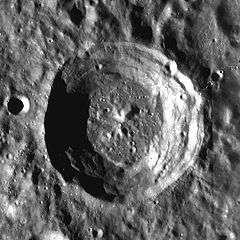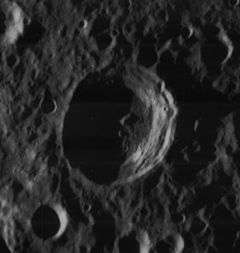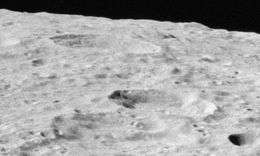Boss (crater)
Boss is a lunar impact crater that is located along the northeast rim of the Moon's near side. Due to its location, the crater is viewed from the side by observers on the Earth, and its visibility is subject to libration effects.
 LRO image | |
| Coordinates | 45.8°N 89.2°E |
|---|---|
| Diameter | 47 km |
| Depth | Unknown |
| Colongitude | 274° at sunrise |
| Eponym | Lewis Boss |


This formation has not been significantly eroded by impacts, and it retains a well-defined outer rim that is not overlain by smaller craters of note. The inner wall is wide and has a terraced surface. The interior floor has a low central peak that is offset slightly to the north from the midpoint.
The closest named craters are Vashakidze to the southeast on the far side of the Moon, and the heavily eroded Riemann to the south. Further to the southwest is the prominent crater Gauss, and to the north-northwest is the Mare Humboldtianum.
The crater is named for astronomer Lewis Boss.[1]
Satellite craters
By convention these features are identified on lunar maps by placing the letter on the side of the crater midpoint that is closest to Boss.
| Boss | Latitude | Longitude | Diameter |
|---|---|---|---|
| A | 52.3° N | 80.3° E | 27 km |
| B | 52.0° N | 77.1° E | 12 km |
| C | 52.2° N | 76.4° E | 21 km |
| D | 44.9° N | 87.4° E | 15 km |
| F | 54.5° N | 86.8° E | 36 km (Legend) |
| K | 49.6° N | 80.7° E | 19 km |
| L | 50.9° N | 82.3° E | 40 km |
| M | 52.0° N | 83.8° E | 13 km |
| N | 52.2° N | 85.2° E | 16 km |
References
- Greeley, Ronald & Batson, Raymond (2001). The Compact NASA Atlas of the Solar System. Cambridge University Press. p. 363. ISBN 978-0-521-80633-6.
Further reading
- Andersson, L. E.; Whitaker, E. A. (1982). NASA Catalogue of Lunar Nomenclature. NASA RP-1097.CS1 maint: ref=harv (link)
- Blue, Jennifer (July 25, 2007). "Gazetteer of Planetary Nomenclature". USGS. Retrieved 2007-08-05.CS1 maint: ref=harv (link)
- Bussey, B.; Spudis, P. (2004). The Clementine Atlas of the Moon. New York: Cambridge University Press. ISBN 978-0-521-81528-4.CS1 maint: ref=harv (link)
- Cocks, Elijah E.; Cocks, Josiah C. (1995). Who's Who on the Moon: A Biographical Dictionary of Lunar Nomenclature. Tudor Publishers. ISBN 978-0-936389-27-1.CS1 maint: ref=harv (link)
- McDowell, Jonathan (July 15, 2007). "Lunar Nomenclature". Jonathan's Space Report. Retrieved 2007-10-24.CS1 maint: ref=harv (link)
- Menzel, D. H.; Minnaert, M.; Levin, B.; Dollfus, A.; Bell, B. (1971). "Report on Lunar Nomenclature by the Working Group of Commission 17 of the IAU". Space Science Reviews. 12 (2): 136–186. Bibcode:1971SSRv...12..136M. doi:10.1007/BF00171763.CS1 maint: ref=harv (link)
- Moore, Patrick (2001). On the Moon. Sterling Publishing Co. ISBN 978-0-304-35469-6.CS1 maint: ref=harv (link)
- Price, Fred W. (1988). The Moon Observer's Handbook. Cambridge University Press. ISBN 978-0-521-33500-3.CS1 maint: ref=harv (link)
- Rükl, Antonín (1990). Atlas of the Moon. Kalmbach Books. ISBN 978-0-913135-17-4.CS1 maint: ref=harv (link)
- Webb, Rev. T. W. (1962). Celestial Objects for Common Telescopes (6th revised ed.). Dover. ISBN 978-0-486-20917-3.CS1 maint: ref=harv (link)
- Whitaker, Ewen A. (1999). Mapping and Naming the Moon. Cambridge University Press. ISBN 978-0-521-62248-6.CS1 maint: ref=harv (link)
- Wlasuk, Peter T. (2000). Observing the Moon. Springer. ISBN 978-1-85233-193-1.CS1 maint: ref=harv (link)
